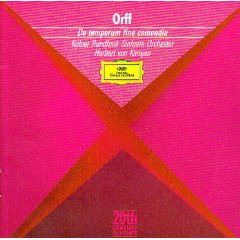Carl Orff - De Temporum Fine Comoedia (Karajan) [1974]
Carl Orff - De Temporum Fine Comoedia (Karajan) [1974]

Part 1. Die Sibyllen
1) "Heis - Heis - theos estin" [7:09]
2) "Opse theu g'aleusi myloi" [3:18]
3) "Pasin, pasin homu" [8:49]
4) "Cho - neuso gar hapanta kai" [3:01]
5) "Vae, vae ibunt, ibunt" [0:53]
Part 2. Die Anachoreten
6) "Upote, maepote..." [3:25]
7) "Unus solus deus ab aeterno" [2:32]
8) "Nicht Satanas, der Widersacher" [1:00]
9) "Mundus, terrenus" [4:12]
10) "Wann endet die Zeit?" [1:15]
11) "Gott, schenk uns Wahrsagung" [3:55]
Part 3. Dies Illa
12) "Wi irren wir hin, verloren, verlassen" [6:39]
13) "Kyrie, Kyrie, Kyrie" [1:18]
14) "Angor, timor, horror, terror" [2:58]
15) "Omne genus daemoniorum" [1:35]
16) "Vae, vae, portae inferi" [0:53]
17) "Pater peccavi" [4:33]
18) "Con sublima spiritualità" [4:51]
Kölner Rundfunkchor
RIAS Kammerchor
Peter Schreier
Christa Ludwig
Rolf Boysen
Der Tölzer Knabenchor
Kölner Rundfunk Sinfonieorchester
Herbert von Karajan
Orff uses the word Comoedia here in its classical meaning of a stage work that does not end tragically or catastrophically. This work, completed in 1971 and revised somewhat after the Salzburg Festival performance of 1973, is Orff's last major work; although he lived for about another decade, he considered it a proper culmination to his life work.
The ensemble ranges from the expected Orff piano and percussion "magic" sonorities to that of an almost full symphony orchestra (violins and, I think, violas, are omitted from the orchestra proper, although a quartet of violas is used in the instrumental conclusion of the work). At times, unusually among the Orff works discussed here, the chorus is accompanied by a driving rhythmically complex texture of only low drums. While Orff's music in general is almost pristine in its diatonicism, here, as apocalypse approaches, more and more chromatic notes are added to the chordal texture. This is not done to create atonality per se, or to use enriched harmonies in any traditionally functional way (that is, to accomplish or anticipate key modulations) but only to make the sonorities more all-embracing, more cosmic, as it were. As a result, at the end of the work in particular, the sound and rhythms of the work become denser and more crushing in effect. Thus, there is an unusual sense of musical drama.
The culmination of the comoedia is the appearance of Satan; after the dissolution of the rest of God's handiwork, Satan at last emerges and confesses that he has sinned and begs forgiveness. His demonic aspect disappears, and it is revealed that God has forgiven even Satan, and restored him to his former full glory as the Angel Lucifer, rebellious no more. At this point, chromaticism disappears from the score, leaving the quartet of violas to play the Bach chorale "Before Thy Throne, " in a varied form.
The result is a fascinating work, much deeper and more disturbing that the famous "Carmina Burana." ---Joseph Stevenson, Rovi
download: uploaded yandex 4shared mediafire solidfiles mega filecloudio nornar ziddu
Zmieniony (Środa, 05 Marzec 2014 16:44)








